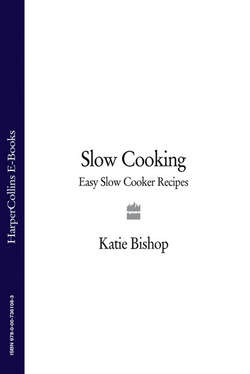Читать книгу Slow Cooking: Easy Slow Cooker Recipes - Katie Bishop - Страница 12
Cooking in a slow cooker
ОглавлениеSlow-cooked food should be left to its own devices, so unless the recipe suggests it, food is best left un-stirred with the lid sealed and undisturbed. As tempting as it may seem, lifting the lid to check on progress will cause the cooker to lose heat and moisture, which can affect the quality of the final dish. This is particularly important in the first hour or so of cooking, as this is the time that the cooker is heating the food to a safe and optimal temperature.
Despite being very economical and transferring a limited amount of heat and energy into the atmosphere, the area immediately around the slow cooker will become hot. So using your antique dining table as a base will not serve you well, potentially causing damage to the surface. Instead use a heatproof surface or worktop.
Food should never be reheated in a slow cooker (although Christmas pudding is safe), as it will not heat to a point where the food becomes safe from harmful bacteria and potential food poisoning bugs. Always reheat slow-cooked foods in a pan on the hob, in the microwave or in the oven. Equally, don’t leave food to cool down in the slow cooker, as this will create the perfect conditions for unpleasant bugs to multiply – instead, always remove it to another dish.
Check your manufacturer’s instructions, but most slow cookers require at least some liquid in the base of the dish to operate properly. You may spot a couple of recipes in this book where this does not happen – this is because these recipes include ingredients that naturally contain a high level of moisture, or there is a large quantity of ingredients, which will create a lot of additional condensation quickly, and therefore a lot of moisture of their own. In some cases, using this method enables some caramelisation of the ingredients in the slow cooker with great results.
